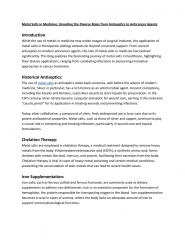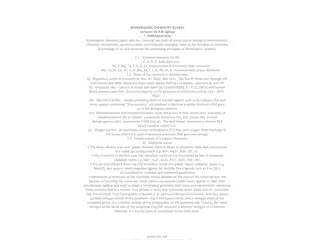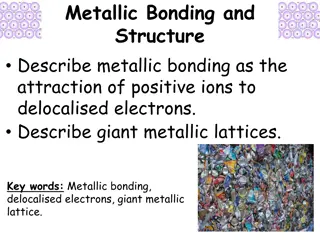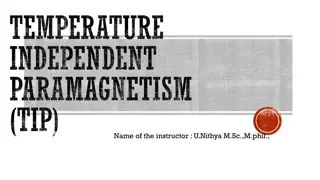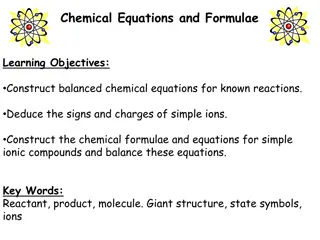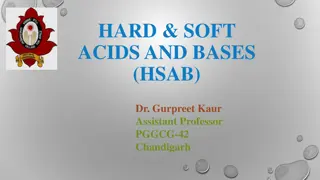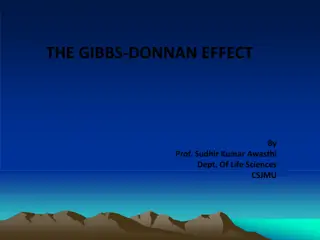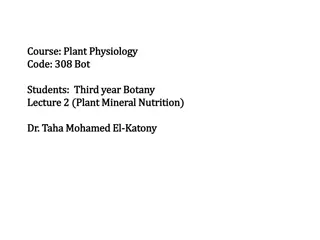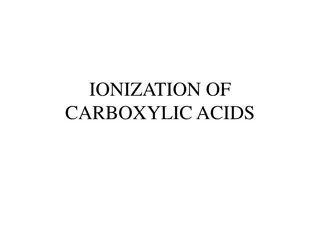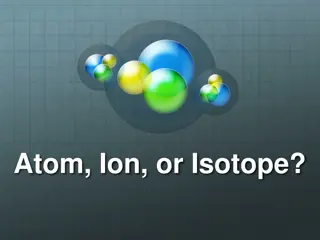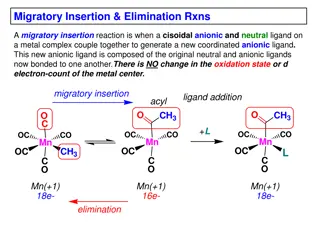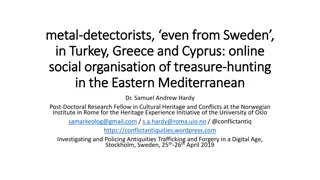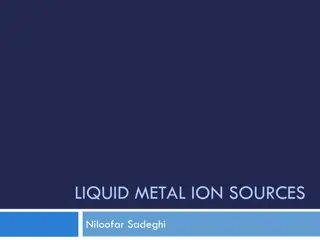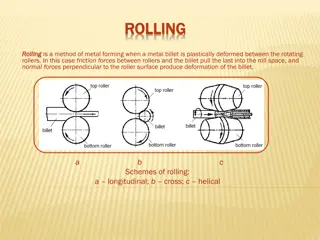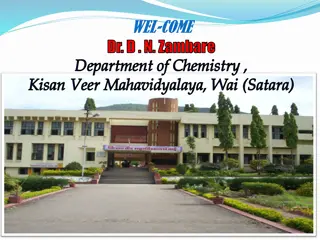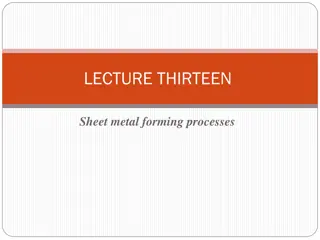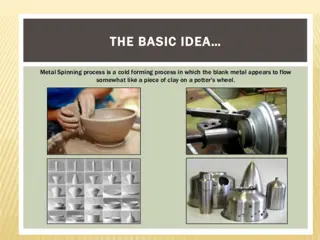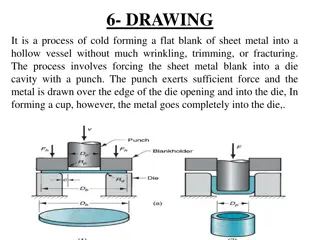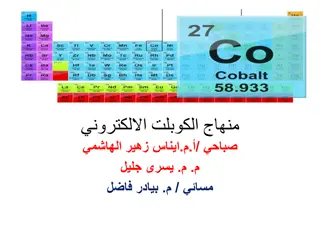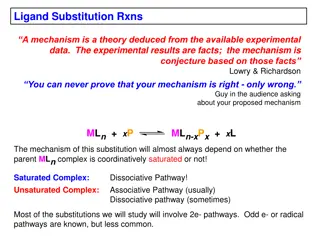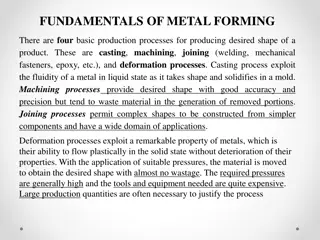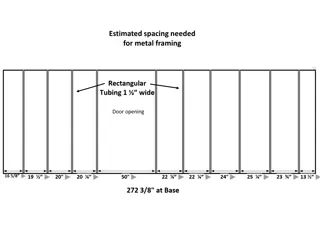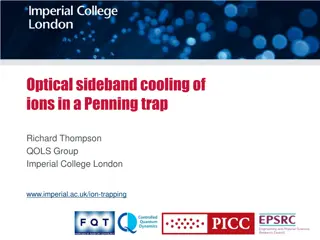Metal Salts in Medicine_ From Antiseptics to Anticancer Agents
While the use of metals in medicine may evoke images of surgical implants, the application of metal salts in therapeutic settings extends far beyond structural support. From ancient antiseptics to modern anticancer agents, the role of metal salts in medicine has evolved significantly. This blog expl
9 views • 3 slides
Scrap Metal in Clayton That Offers Expert Collection & Transport Services
JJ Scrap Metals, located in Clayton, offers professional scrap metal collection and transportation services. With a team of experts boasting extensive industry knowledge, we assure you of maximising returns for your metals. Our goal is to provide efficient and reliable services, making it convenient
5 views • 4 slides
Organometallic Chemistry (CHEM 42 1)
Organometallic chemistry delves into compounds with carbon-metal bonds, merging concepts from inorganic and organic chemistry. The field encompasses diverse compounds like ferrocene and tris(triphenylphosphine)rhodium carbonyl hydride, with nomenclature based on naming organic groups and adding meta
1 views • 13 slides
Transition Metals Organometallic Compounds Overview
Transition metals bonded with organometallic compounds like metal alkyls, aryls, and hydrides are common in chemistry. Ligands are crucial for stabilizing these complexes, with carbon-based ligands exhibiting diverse binding modes based on the metal's hybridization state. Preparation methods for tra
1 views • 25 slides
Crystal Field Theory in Transition Metal Complexes
Crystal Field Theory (CFT) explains the colors and magnetic properties of transition metal complexes. It focuses on the energy changes in d-orbitals of metal ions caused by surrounding ligands. This theory, developed in 1929, provides insights into the bonding interactions in complex compounds. The
10 views • 44 slides
Maximise Returns on Metal Recycling with Affordable Scrap Metal Prices
In today's eco-conscious world, JJ Scrap Metals stands out as a beacon of sustainability and profitability in the scrap metal industry. With a proud history of serving areas like Moorabbin, Dandenong South, Pakenham, and beyond, we're not just any scrap metal collector but your partner in ensuring t
3 views • 5 slides
Metal wall art
Elevate your living space with \"TheOnlyPlanetEarth\" metal wall art decor, curated to bring a touch of modern elegance to your home. Perfect for living rooms, this exquisite piece is available in Singapore, Indonesia, Malaysia, Dubai, Saudi Arabia, and Europe. Our services include outdoor metal art
2 views • 1 slides
Get Fair Scrap Metal Prices in Melbourne at JJ Scrap Metals
Scrap metal can negatively impact the environment if not managed properly, necessitating careful handling and recycling. \nAt JJ Scrap Metals, we have the expertise to recycle tons of used metals, including copper, aluminium, brass, lead, batteries, iron, wrecked cars, and vehicles. \nAs Melbourne's
1 views • 5 slides
Metal Gates and Fence Installation Services
Metal gates are an excellent choice for enhancing the security and aesthetic appeal of your property in Redmond. At Electric Metal gates in Redmonds, we specialize in the design, fabrication, and installation of high-quality metal gates tailored to meet your specific needs. Our metal gates come in v
4 views • 3 slides
Exploring Bioinorganic Chemistry: Essential Elements and Structural Functions in Biological Systems
Bioinorganic chemistry focuses on the reactivity of metal ions in biological settings, with essential elements like C, H, N, O, and various mineral macro and micronutrients playing key roles in regulatory, structural, electron transfer, enzyme function, and oxygen transport processes. Understanding
0 views • 10 slides
Metal Roof Painting of Factories At Commercial Painting Services
Commercial Painting Services has years of experience dealing with metal roof painting clients that have neglected their metal roof maintenance. \/\/ \/metal-roof-painting-michigan-ohio-indiana
1 views • 13 slides
Understanding Metallic Bonding and Giant Metallic Lattices
Metallic bonding involves the attraction of positive metal ions to delocalized electrons, forming giant metallic lattices. In this structure, positive metal ions occupy fixed positions while electrons move freely throughout. This bonding is different from covalent bonding as it is delocalized, leadi
1 views • 19 slides
Understanding Temperature Independent Paramagnetism (TIP) and Anomalous Magnetic Moments in Metal Ions
Temperature Independent Paramagnetism (TIP) explains the second-order Zeeman effect's magnetic susceptibility unaffected by temperature changes. Anomalous magnetic moments are observed in metal ions, deviating from predicted values based on electron angular momenta. The interaction of spin states in
1 views • 15 slides
Understanding Chemical Equations and Formulae
Learn to construct balanced chemical equations for known reactions, deduce signs and charges of simple ions, and create chemical formulae for ionic compounds. Understand the concepts of reactants, products, molecules, giant structures, state symbols, and chemical formulas for various substances. Gai
3 views • 7 slides
Understanding Hard and Soft Acids and Bases (HSAB Principles) by Dr. Gurpreet Kaur
Delve into the world of Hard and Soft Acids and Bases (HSAB) with Dr. Gurpreet Kaur as she explains the characteristics of hard and soft acids, Pearson's HSAB principle, applications such as predictions of coordination in complexes, poisonings of metal catalysts, and the classification of acids and
2 views • 17 slides
Chemistry Concepts: Valence Electrons, Ion Charges, and Ionic Compounds
Explore various key concepts in chemistry such as valence electrons in magnesium, Lewis Dot structure for silicon, charges on ions like strontium, formation of ions to achieve noble-gas electron configuration, elements forming ions with specific charges, and the octet rule. Learn about the character
1 views • 48 slides
Analysis of 1st Group of Cations: Ag+ and Pb2+ Ions
The analysis of cations in the 1st group involving Ag+ and Pb2+ ions is carried out by precipitating insoluble chloride salts in the presence of diluted HCl solution. The solubility products of AgCl, PbCl2, and Hg2Cl2 play a crucial role in the precipitation reactions. Various reagents such as HCl,
0 views • 7 slides
Understanding the Gibbs-Donnan Effect in Biological Systems
The Gibbs-Donnan Effect, named after physicists Gibbs and Donnan, explains the selective permeability of membranes to ions, leading to the establishment of Donnan potential. This phenomenon affects the distribution of ions and proteins across cell membranes, influencing processes like osmosis and io
0 views • 27 slides
Plant Mineral Nutrition: Absorption and Circulation of Ions in Roots
Plant mineral nutrition involves the absorption and translocation of ions across roots. Salts are absorbed passively and actively, with ions moving into the root's apoplasm via free diffusion. The Casparian strip in endodermal cells acts as a barrier, allowing ions to pass only through the protoplas
0 views • 27 slides
Understanding Ionization of Carboxylic Acids
Carboxylic acids, as proton donors, can undergo ionization to form ions in chemical reactions based on the Brønsted-Lowry theory. Ionization involves the complete loss or gain of electrons, leading to the formation of cations (positively charged ions) and anions (negatively charged ions). Through e
1 views • 13 slides
Understanding Complex Ions and Coordinate Bonds in Chemistry
Complex ions in chemistry are formed when transition metals or their ions bond with ligands through coordinate bonds. Ligands utilize their lone pairs of electrons to form dative covalent bonds with transition metals, determining the coordination number of the cation. Complex ions play a crucial rol
1 views • 29 slides
Understanding Valence Electrons and Ionic Charges in Elemental Bonding
Valence electrons play a crucial role in the formation of ions as elements combine. Nonmetals gain electrons to become negatively charged ions, while metals lose electrons to become positively charged ions. This process leads to the creation of electrically attractive elements open for bonding. The
0 views • 17 slides
Understanding Atoms, Ions, and Isotopes in Chemistry
Atoms are neutral with equal protons and electrons. Ions are charged atoms resulting from gaining or losing electrons, while isotopes are atoms with varying numbers of neutrons. The atomic number always signifies the number of protons in an atom, unaffected by electron or neutron changes. Explore th
2 views • 5 slides
Understanding Metal Toxicity: Risks, Detection, and Impact on Health
Metal toxicity is a growing concern affecting many individuals today, with 41% of Delhi & NCR population testing positive for severe heavy metal toxicity. This survey by Daivam Wellness aims to create awareness about the dangers of metal toxicity and its impact on health, including diseases such as
0 views • 7 slides
Insights into Migratory Insertion and Elimination Reactions in Metal Complexes
Migratory insertion in metal complexes involves the coupling of a cisoidal anionic and neutral ligand to form a new coordinated anionic ligand without changing the metal center's oxidation state or d-electron count. This process requires cisoidality between the reacting ligands and a vacant coordina
0 views • 19 slides
Insights on Biogeochemical Processes and Metal Interactions in Marine Environments
Delve into the intricate relationships between metals, stoichiometry, and biological quotas in marine ecosystems. Explore the impact of metal interactions on biogeochemical provinces, resource supply stoichiometry, and the constraints they impose on marine biota. Uncover how deep chlorophyll maxima,
0 views • 5 slides
Metal Detectorists and Antiquities Laws in Eastern Mediterranean
Post-Doctoral Research Fellow Dr. Samuel Andrew Hardy explores treasure hunting and metal detecting by detectorists from Sweden in Turkey, Greece, and Cyprus. The legal frameworks regarding metal detecting and excavation of archaeological sites differ in Cyprus, Greece, and Turkey. While unlicensed
0 views • 11 slides
Understanding Liquid Metal Ion Sources in Nanotechnology
Liquid Metal Ion Sources (LMIS) are crucial tools in nanotechnology, with needle and capillary types for ion emission. LMIS operate on the formation of liquid metal cones to emit ions, driven by electric fields and surface tension. Taylor cones and strong electric fields play key roles, while stabil
0 views • 10 slides
Methods of Metal Forming: Rolling and Related Techniques
Rolling is a metal forming method that involves shaping metal billets between rotating rollers, utilizing friction and normal forces to deform the material. The process includes sheet rolling, slabbing, various sections of rolled metal, and different equipment used in metal forming. Other methods di
0 views • 5 slides
Understanding Electrolyte Activity Coefficients and Equilibrium Constants
This article delves into the practical aspects of dealing with individual ions in aqueous solutions, particularly focusing on partitioning thermodynamic parameters between ions in salts. It explores the Debye-Hückel theory, which explains the electrostatic interactions between ions in solution and
0 views • 20 slides
Understanding Chelation Chemistry: Structural Requirements, Ligands, and Applications
Chelation chemistry involves the formation of specific complexes known as chelates, characterized by ligands that coordinate with a central metal ion. This article explores the structural requirements for chelate formation, the role of chelating agents like EDTA and DMG, and the difference between m
0 views • 27 slides
Overview of Sheet Metal Forming Processes
Products made of sheet metals are prevalent in consumer and industrial applications, encompassing items like beverage cans, cookware, car bodies, and more. The primary sheet-metal processes include cutting, bending, and drawing, each serving different purposes in shaping sheet metals. Cutting operat
0 views • 6 slides
Understanding Metal Spinning Process and Techniques
Metal spinning, also known as spin forming or metal turning, is a metalworking process that involves shaping a disc or tube of metal by rotating it at high speed. This process does not involve material removal but rather the forming of sheet material over an existing shape. Hot spinning is a variati
0 views • 28 slides
Metal Drawing Process for Creating Hollow Vessels
Metal drawing is a cold forming process that transforms a flat sheet metal blank into a hollow vessel without wrinkles or fractures. By applying force with a punch, the metal is drawn into a die cavity to shape the blank into a cup-like form. This process involves setup similar to blanking but with
0 views • 19 slides
Detecting Cobalt(II) Ion Reactions in Solutions
This experiment outlines various methods for detecting Cobalt(II) ions (Co2+) in solution using reagents like sodium hydroxide, ammonia, sodium or potassium carbonate, and more. Observations and changes in color are noted throughout the process to identify the presence of the Cobalt ions. The reacti
0 views • 19 slides
Understanding Ligand Substitution Reactions in Metal Complexes
Ligand substitution reactions in metal complexes involve the replacement of one ligand with another, impacting the coordination around the metal center. The mechanism of these reactions, associative or dissociative, is influenced by factors like coordination saturation and electron count. Experiment
0 views • 20 slides
Basics of Metal Forming Processes
Metal forming processes play a crucial role in shaping products, with casting, machining, joining, and deformation being the primary methods. Each process has its advantages and limitations, catering to different needs for accuracy, material wastage, complexity, and production quantities. Understand
0 views • 22 slides
Comprehensive Metal Framing and Building Support Specifications
Detailed images and information on estimated spacing for metal framing, metal framing needed for the third floor barrel piece, third floor barrel section and building wall metal support beams, and specifications for window panel cutouts.
0 views • 4 slides
Optical Sideband Cooling of Ions in a Penning Trap - Research Summary
Researchers at Imperial College London, led by Richard Thompson, have made significant contributions in the field of optical sideband cooling of ions in a Penning trap. This technique involves laser cooling in the trap, large Lamb-Dicke parameters, sideband cooling of ions, coherent manipulation of
0 views • 34 slides
Understanding Acids and Bases in Chemistry
Acids, derived from the Latin word "acidus" meaning sour, produce hydrogen ions when dissolved in water. Bases, defined as compounds dissociating into metal ions and hydroxide ions in water, have common characteristics like a bitter taste. The Brønsted-Lowry theory expanded the definitions of acids
1 views • 50 slides
